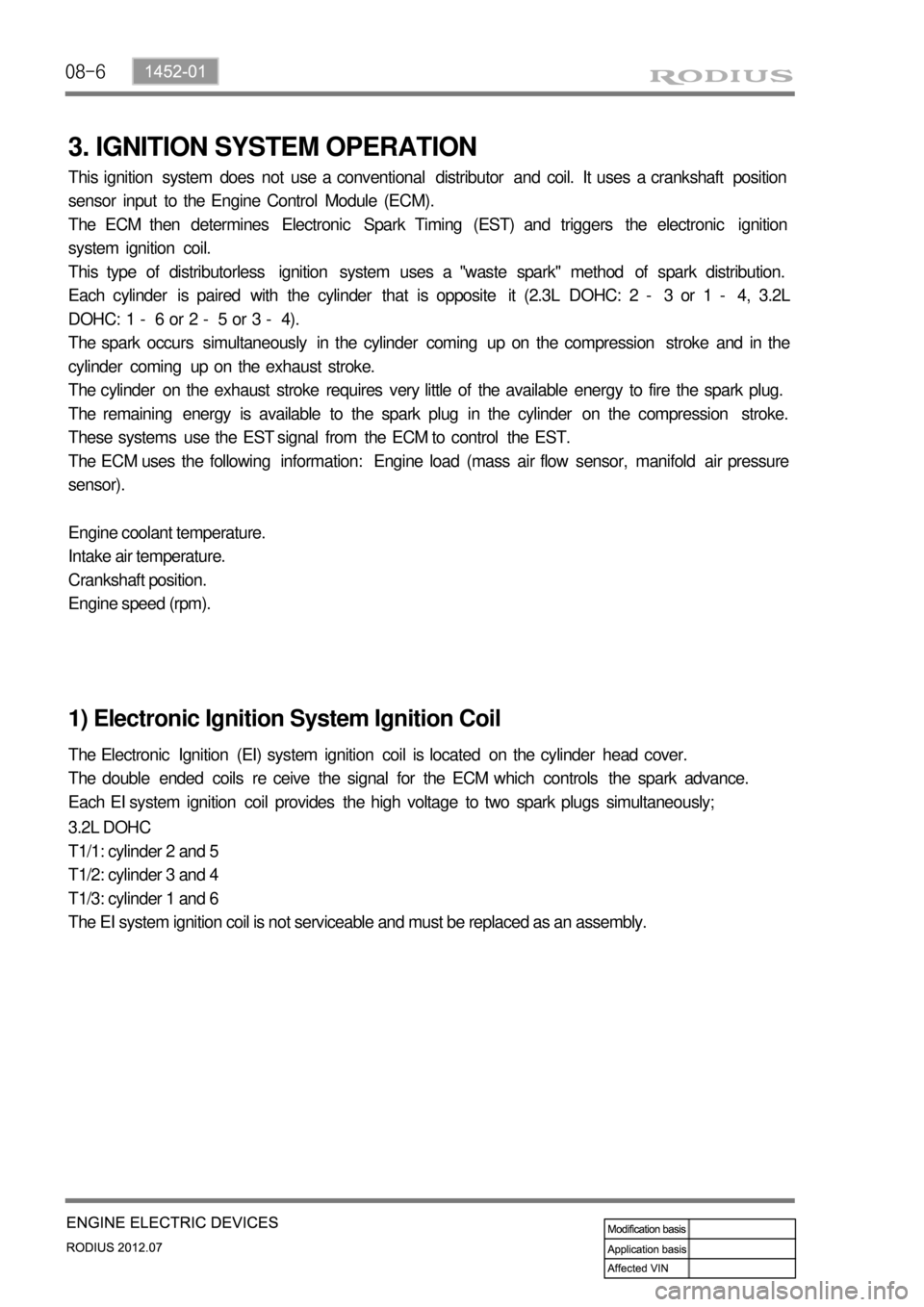Page 403 of 715

08-6
3. IGNITION SYSTEM OPERATION
This ignition system does not use a conventional distributor and coil. It uses a crankshaft position
sensor input to the Engine Control Module (ECM).
The ECM then determines Electronic Spark Timing (EST) and triggers the electronic ignition
system ignition coil.
This type of distributorless ignition system uses a "waste spark" method of spark distribution.
Each cylinder is paired with the cylinder that is opposite it (2.3L DOHC: 2 - 3 or 1 - 4, 3.2L
DOHC: 1 - 6 or 2 - 5 or 3 - 4).
The spark occurs simultaneously in the cylinder coming up on the compression stroke and in the
cylinder coming up on the exhaust stroke.
The cylinder on the exhaust stroke requires very little of the available energy to fire the spark plug.
The remaining energy is available to the spark plug in the cylinder on the compression stroke.
These systems use the EST signal from the ECM to control the EST.
The ECM uses the following information: Engine load (mass air flow sensor, manifold air pressure
sensor).
Engine coolant temperature.
Intake air temperature.
Crankshaft position.
Engine speed (rpm).
1) Electronic Ignition System Ignition Coil
The Electronic Ignition (EI) system ignition coil is located on the cylinder head cover.
The double ended coils re ceive the signal for the ECM which controls the spark advance.
Each EI system ignition coil provides the high voltage to two spark plugs simultaneously;
3.2L DOHC
T1/1: cylinder 2 and 5
T1/2: cylinder 3 and 4
T1/3: cylinder 1 and 6
The EI system ignition coil is not serviceable and must be replaced as an assembly.
Page 658 of 715
01-36810-30
Rear air conditioner module assembly - bottom of rear left
Engine ECU - passenger's
footstep
CondenserRecevier driver-condenser
right
Rear fan speed dial
Sub-condenser - right wheel
front
Absorbs moisture in the
refrigerant and reserves
refrigerant to supply
smoothly. *Instslled in front of vehicle and
condenses vapor refrigerant into
low temperature and high
pressure liquid refrigerant *
Condenses high temperature and
high pressure vapor refrigerant into
low-temperature-high-pressure
liquid refrigerant. *
Detects A/C AUTO switch position,
coolant temperature, engine
condition and driving condition to
control the air conditioner *
A sensor that detects coolant
temperature and transmits to
engine ECU *
Blower motor
Power transistor
Air conditoner high
pressure/low
pressure pipe
Air mix door
actuator
Front
Rear
A switch that controls the rear air
conditioner module. *
Collant temperature sensor -
on engine
Page 663 of 715
01-8
2. SYSTEM BLOCK DIAGRAM
A/C compressor OFF conditions ▶
Coolant temperature: over 115℃
Engine speed: over 4,500 rpm for more than 2 seconds
Engine speed: below 650 rpm
Maximum output due to abrupt acceleration
Excessive acceleration
Increased load during engine idling (to prevent the engine from shutting off)
Refrigerant pressure: over 32 bar or below 2 bar
Defects in A/C related system (refrigerant pressure sensor, coolant temperature sensor,
cooling fan) 1.
2.
3.
4.
5.
6.
7.
8.
Page 664 of 715
01-96810-30
3. CIRCUIT DIAGRAM
1) FATC (Full Auto Temperature Control)
D20DTR, PWM Motor, Coolant Fan(SUB) relay ▶